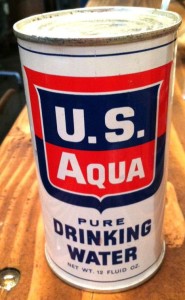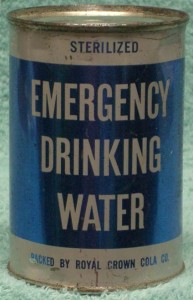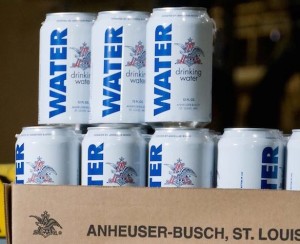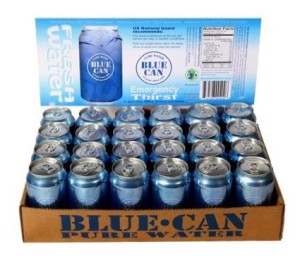It’s kind of interesting to look back on the history prepping back to the golden-age of the Red Scare and Cuban Missile Crisis and seeing the gear that was marketed towards those wanting to survive the inevitable nukefest.
 One of the things that I often see pictures of in old bomb shelters is canned water. More specifically, drinking water that was packaged in cans like beer or other canned food would be. Here’s an example of what I’m talking about. Notice that this was in the days of dinosaurs before the pull-top can was invented. So, if you wanted to slake your thirst in the post-nuke world, you needed the old-fashioned church key to open it. Although there are plenty of these relics floating around, and people come across them from time to time and post pictures of them on the internet, very infrequently do you find those same people saying if the cans were still full or not. Assuming the cans were not lined with any particular barrier coating (which seems pretty likely considering the era), and their steel construction, the cans probably succumbed to rusting pretty quickly. (This, by the way, is why those old Civil Defense water barrels were not stored full of water, but rather stored in such a condition as to allow them to be rapidly filled when the warnings were given.)
One of the things that I often see pictures of in old bomb shelters is canned water. More specifically, drinking water that was packaged in cans like beer or other canned food would be. Here’s an example of what I’m talking about. Notice that this was in the days of dinosaurs before the pull-top can was invented. So, if you wanted to slake your thirst in the post-nuke world, you needed the old-fashioned church key to open it. Although there are plenty of these relics floating around, and people come across them from time to time and post pictures of them on the internet, very infrequently do you find those same people saying if the cans were still full or not. Assuming the cans were not lined with any particular barrier coating (which seems pretty likely considering the era), and their steel construction, the cans probably succumbed to rusting pretty quickly. (This, by the way, is why those old Civil Defense water barrels were not stored full of water, but rather stored in such a condition as to allow them to be rapidly filled when the warnings were given.)
 From a manufacturing standpoint, the market for this sort of thing would have been a no-brainer for a company that was already involved in the bottling/canning process. For example, here’s some canned water that was canned by the folks at Royal Crown, or as we know it today – RC Cola. If you’ve already got the canning operation set up to make pop, why not just turn the taps on and can some water at the same time? No additional capital investment and a whole new market to sell to….seems like a win to me. But, realistically, that market for canned water, even at the peak of the crisis, probably couldn’t even begin to compare to the market for the regular product.
From a manufacturing standpoint, the market for this sort of thing would have been a no-brainer for a company that was already involved in the bottling/canning process. For example, here’s some canned water that was canned by the folks at Royal Crown, or as we know it today – RC Cola. If you’ve already got the canning operation set up to make pop, why not just turn the taps on and can some water at the same time? No additional capital investment and a whole new market to sell to….seems like a win to me. But, realistically, that market for canned water, even at the peak of the crisis, probably couldn’t even begin to compare to the market for the regular product.
 Interestingly, canned water actually does turn up these days in disasters. The folks at Anheuser-Busch, most famous for Budweiser beer, periodically use their resources to run off batches of canned water to be distributed in disaster areas. Compared to the old cans, these things are rocketships…pull-top cans so no opener is required, lined interiors to preserve taste, and aluminum construction to reduce weight and increase durability. And, considering the manufacturing technology and resources of a company like A-B, they probably produce more of these things in an 8-hour shift than most companies could have produced in a week back in the days of Sputnik.
Interestingly, canned water actually does turn up these days in disasters. The folks at Anheuser-Busch, most famous for Budweiser beer, periodically use their resources to run off batches of canned water to be distributed in disaster areas. Compared to the old cans, these things are rocketships…pull-top cans so no opener is required, lined interiors to preserve taste, and aluminum construction to reduce weight and increase durability. And, considering the manufacturing technology and resources of a company like A-B, they probably produce more of these things in an 8-hour shift than most companies could have produced in a week back in the days of Sputnik.
 Interestingly, if a person was interested in getting some of this sort of thing for their own bunker you can find it online without having to hang around a disaster relief tent. There’s at least one vendor on Amazon selling the stuff. (Blue Can) And although I rather like the idea of the convenience and durability of an aluminum can, I think that, when you really think about it, any advantages offered by an aluminum can are pretty much available in other forms…most specifically the ubiquitous plastic water bottle that we get at WalMart for around $5 a case. (Versus what amounts to about a buck a can for the aluminum cased stuff.)
Interestingly, if a person was interested in getting some of this sort of thing for their own bunker you can find it online without having to hang around a disaster relief tent. There’s at least one vendor on Amazon selling the stuff. (Blue Can) And although I rather like the idea of the convenience and durability of an aluminum can, I think that, when you really think about it, any advantages offered by an aluminum can are pretty much available in other forms…most specifically the ubiquitous plastic water bottle that we get at WalMart for around $5 a case. (Versus what amounts to about a buck a can for the aluminum cased stuff.)
I can’t speak for everyone, but my own experience has been that the plastic water bottles are exceptionally durable and probably more durable than the aluminum cans. The biggest issue that springs to mind is what happens in cold weather…I’ve had cans of Coke freeze and explode like an M67, but I’ve never had one of the plastic bottles explode. The bottles also have a bit of ‘give’ to them so things that might puncture an aluminum can don’t necessarily have the same effect on the plastic bottle. In fact, pretty much the only advantage I can come up with for the can over the plastic bottle is the opaque nature of the can preventing light transmission and inhibiting any type of growths.
 Two other packaging options are the ‘juice box’ style of packaging, which is also pretty tough to find, and the foil pouches that we often see marketed specifically towards preparedness. The boxes seem like a clever idea but I think theyre the least durable and therefore the least attractive option. I do very much like the foil pouches. While I don’t think they have the puncture resistance of the plastic bottles, I very much like their small serving size…their small size means that if they freeze (like in your car in the winter) you can thaw them quickly and easily by just tucking them under your arm or sitting on them. Contrast that with trying to quick-thaw a 16 oz. frozen plastic bottle of water.
Two other packaging options are the ‘juice box’ style of packaging, which is also pretty tough to find, and the foil pouches that we often see marketed specifically towards preparedness. The boxes seem like a clever idea but I think theyre the least durable and therefore the least attractive option. I do very much like the foil pouches. While I don’t think they have the puncture resistance of the plastic bottles, I very much like their small serving size…their small size means that if they freeze (like in your car in the winter) you can thaw them quickly and easily by just tucking them under your arm or sitting on them. Contrast that with trying to quick-thaw a 16 oz. frozen plastic bottle of water.
It’s also worth pointing out that if you’re the DIY type of guy you can actually ‘can’ water same as you’d can fruits or other foods using your pressure cooker. The water is completely sterilized, the containers are sterilized, and pretty much the only weak point is the glass container.

The plastic being used these days for bottled water is so thin that I wouldn’t trust it much for long term storage. However, it does make sense to me that if you have extra home canning supplies and a limited long term supply of water, you could pressure can water easily. I have the Tattler reusable lids and have canned water using them with no problem. (Some folks might not realize it, but you need to have your pressure canner filled with jars to prevent them from rattling, or falling over and breaking during the canning process. So, when I have less than a full canner’s worth of stuff to can, I fill the extra jars with water and process them, too.)
I dunno…the plastic on those milk-jug-style gallons of water tend to be thin and cheap, but the plastic on the 12-16-20 oz. bottles has been, in my experience, very durable. I’ve some 15 year old 2-liter bottles of water in storage and theyre just as tough as ever.
Those small plastic bottles are designed with expansion sections to avoid breakage when frozen. So are the aluminum cans, it seems. (got a roommate who occasionally forgets to remove soda cans from the freezer that he is quick chilling. The top and bottom end up bulging out, but they don’t pop. I think it may do something to the taste, as he doesn’t consume them, just pops the tab, and leaves them in the sink to drain after thawing.)
The plastic bottles and aluminum cans were made thinner a few years ago, so they are much more delicate now. Can’t let them roll around on the car floor, as they end up with cracks or punctures. Even the plastic caps were downsized, so getting a good grip on them is literally a pain, due to not enough surface area. Damn engineers, must think everyone is no older than twenties.
Even the tall gallon size bottles had the cap reduced in diameter, which makes them much less useful after the water is gone.
You’re right about the milk jug size containers being very thin. I used to employ them for used oil, but now they develop cracks just sitting there. Bit messy. Half the water ones I get end up developing cracks and dribbling water even before I get around to needing them. Problem is that they seem to be the major container used for distilled type water that is needed for equipment.
My understanding is that the milk jug plastic is specifically designed, for environmental reasons, to break down (esp. after UV exposure) quickly…I’d never store anything in them.
The pouches were mostly used in life rafts. When I had mine and others. the off shore kit contains 24 pouches for a 6 man raft. FWIW
Yeah, I know..I was gonna call them ‘lifeboat ration pouches’ but I figured too many people had never played around with lifeboats enough to know what I meant. Its pretty obvious on the packaging, though, since it covers all the SOLAS and USCG requirments and data it meets.
The CD packaged water was vac-packed (also used in mil survival kits) and if the seal is still good, you can shake the can and it feels like there is a slug of concrete in there – it goes bang, bang on the ends…
Unfortunately the last were packed in very early 1962 and the coatings used may not have held up.
I’ve had the sam results with bottled water (in the clear PETE bottles…I had a flat of bottles in my truck for more than 6 years including summers in the desert and winters in the arctic before I replaced them – they will freeze in the winter but thaw and be fine. The milky, softer plastic used for milk jugs is unsuitable.
I found a seller on Ebay selling new, unused Mylar box wine bags, complete with spout. When filled, the bag holds about 3L. I spent a couple of days and filled 100 of the bags and boxed them individually in some old shipping boxes I had planned on using for online sales (I won’t mention names here, but a certain shipper will provide a wide variety of boxes and sealing tape delivered to your front door for free). I stacked them about 8 boxes high, 3 deep, in my various home closets. Also stored some in 5 gallon buckets in the shed. They are pretty rugged, have not had one of them leak since they were filled. I also carry one in a small rucksack in my vehicle. They seem pretty tolerant to freezing temperatures. I don’t plan on rotating the water, just filtering it when needed.
Thats brilliant. It never occurred to me to hit up eBay for those kind of mylar bags. Well done!
I’ll have to look into wine bags. Very clever.
I bought some wide mouth 2 liter Nalgene HDPE labware bottles. A bit pricey, but they’re very tough bottles, and also available in sizes from 500 ml to 4 liters. 2L is a handy size for dropping into a day pack. They’ve gone through numerous freeze/thaw cycles in the truck, but I do leave some air space for expansion and store them vertically. I suspect the weakest point may be the threaded junction between the cap and the bottle.
Back in Ought ’72, when Hurricane Agnes helped flood the Wyoming Valley, drinking water was – no surprise – sketchy. Several local brewers bubbled up (no pun intended) with canned water, though of the pull tab variety. For whatever reason the canned water had a faint beerish flavor which made it more popular with some and less so with others.
I also have fond memories of #10 cans of shredded chicken, pork, and huge blocks of Authentic Government Cheese.
How long is water good for in a nalgene bottle in the car? I eat my lunch in my car often and sometimes run out of water. Can I just leave nagene bottles of water there for months at a time and drink it safely?
thanks
I guess it depends if the water has been treated with anything to retard growth of algae or other bacteria.
RE: Nalgene labware bottles in the car – I keep a gallon in the truck, in two 2L bottles, and add a third on trips. It’s usually consumed within a month or so, and replaced with a fresh bottle when one is emptied; I use chlorine-treated city tap water for refilling, and don’t add anything else. I’ve got a half dozen 2L bottles and cycle them through the dishwasher as they come out of the truck empty. Never had the water tested, but Nalgene is BPA-free. Big advantage is labware Nalgene is pretty tough stuff – they’re thick bottles, and I’ve never had one leak. I leave air space for freezing, I’d guess freezing a completely full bottle would push the screw-on widemouth top off.
Like Goatlover, I’ve canned water. It’s easy when you have an overabundance of jars & need to stick an extra jar or 2 in the canner. I haven’t had any jars freeze or break, tho over the years I’ve lost a couple to seals that unsealed for some reason. Tho water doesn’t have to be pressure canned – it can be done in the water bath canner, too.
I buy cheap bottled water to keep in the car. I’ve been told that the reason “authorities” recommend replacing stored water bottles after a year is that there is more possibility of the plastic degrading and leaking. So far, I haven’t had that happen.
Any concern about chemicals from cheap plastic water bottles leaching out into your water if those bottles are stored for a long time. I’m not a materials engineer, but for some reason I thought that storing water in those single serve plastic bottles was not advised.
In a crisis, I think I’ll take the risk of 1ppm of some maybe-causes-cancer plastic molecule over dying of dehydration.
I hope it goes without saying that I’ll drink about any water any-where before I allow myself to succumb to death by dehydration. But given the options available to us in pre-preparing, wouldn’t we all rather NOT consume a chemical cocktail slurry fermenting over the course of years in a plastic bottle selected for being the cheapest possible material in order to maximize the slender profit margins of Sam Walton’s shareholders?
Come on Peter, water is cheap. Replace it a couple of times a year (maybe on Memorial Day and Veterans Day?) and be done with the issue.
Spending time and mental energy on something like this is all to common in prepping and usually ends up keeping the person doing it from ACTUALLY prepping.
I can almost guarantee that if you have it in your car you will end up drinking it because you are thirsty and it’s there LONG before the bottle degrades. Or maybe that’s just me.
nick
True. Rotation discipline does resolve the major concern. That said, aren’t thought exercises about the pros and cons of different solution options half the fun of prepping?
@Peter,
“aren’t thought exercises about the pros and cons of different solution options half the fun of prepping?”
Oh absolutely! Fun and valuable. And if you want to use the jargon of the ‘pros’ call it a ‘tabletop exercise.’ 🙂
My response sounded more negative and more personally-aimed than I meant it to. I’m sorry about that. Thank you for your tolerant and sensible response.
I was reacting to a tendency on prepper forums (fora?) that pokes its head up from time to time. I think there is a real tendency to ‘overthink’ some things to the point of paralysis. It shows up in the inability to buy a flashlight because it might not be the ‘perfect’ one. So as the prepper sits reading reviews, agonizing over models, he ends up sitting in the dark when the thunderstorm hits.
It is easy and fun, and has practical benefits to think all the way thru to third and fourth order effects, but it can keep a person from actually prepping.
And that’s what I was reacting to, the fact that we’ll all be dead from the golden horde, the z virus, starvation, or sepsis LONG before we have any effects on our sex hormones from BPA leaching in our stored water….
Again, thanks for your levelheadedness 🙂
nick
Somewhat off topic, but never, ever store water in used milk jugs. No matter how clean you think they are, you can never remove all of the milk that they once contained. The milk deposits will mix with your stored water, creating a toxic cocktail over time.
I’ve been a couple of hydro-powerhouse, for both TVA and Army Corp of Engineers, and in walking around, when I got bored or just looking for a place to have smoke. I’ve seen the 5gal Civil Defense water cans, as well as containers of crackers. I guess, the power house was a bomb shelter, and with the amount of concrete above my head, guess it would be a safe place to be.
Some of the dates I could see, were from the early to mid 60’s, Cuba I guess.